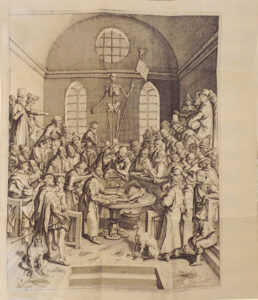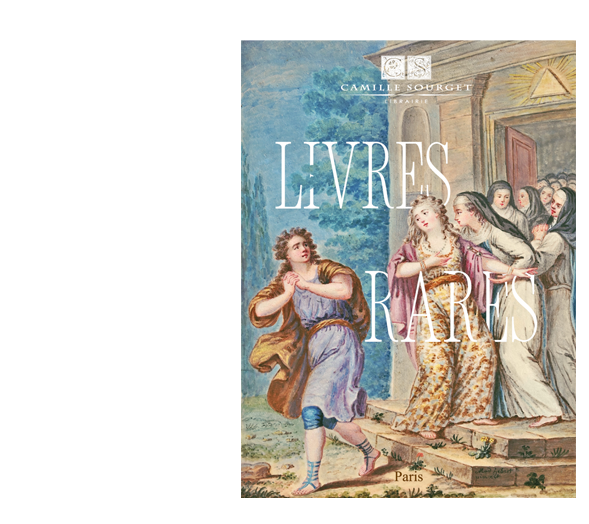Lugduni Batavorum [Leyde], Iodocum a Colster, 1616.
2 parts bound in 1 volume 4to [200 x 140 mm] of: I/ (12) ll. including the title printed in red and black and the portrait of the author at the back, 270 pp., 1 folding frontispiece and 34 engravings in the text; II/ (1) title, 128 pp., 2 folding plates and 25 engravings in the text. Small wormhole in pp. 9 to 55 of the second text, 2 handwritten ex libris on the title-page, old handwritten note in the margin of p. 177. Bound in contemporary full limp overlapping vellum, remains of leather ties, flat spine with handwritten title. Contemporary binding.
Rare original edition of paaw’s comments on Hippocrates and Celsius’ works concerning the head wounds.
Graesse, Trésor de livres rares, V, p. 99.
The Renaissance humanism is marked by a sudden infatuation for anatomy. The first anatomists had to overcome great difficulties. The anatomic lecture halls were slowly built, in Padua in 1490, in Basel in 1588, in Paris in 1608.
The dissection of corpses exposed to important sanctions from the civil and religious authorities.
« Pierre Paaw, a skilful anatomist, was born in Amsterdam in 1564. In 1580, he went to study medicine in Leiden. After four years, he came to France, where he stayed quite a long time in Paris and Orleans. Then he went to Denmark. He was in Rostock in 1587, and was admitted as doctor in medicine, and started to teach anatomy. Little time after, he travelled to Italy in order to hear the lecture of Fabrizio d’Aquapendente. His father’s death obliged him after three months to go back to his homeland ; he went back to Leiden, where, during twenty-eight years, he practised the art of healing with a lot of success, and taught brilliantly anatomy and botanic. He is the one who got the public lecture hall of anatomy of Leiden to be built. Paaw died in 1617. His works contain quite a large number of interesting observations. » (Dezeimeris, Dictionnaire historique de la médecine ancienne et moderne, III, p. 659)
The work contains the author’s comments on Hippocrates and Celsius works. The first text is written in Greek and Latin. Born in 460 BC, Hippocrates was considered as the greatest scholar of his time; he founded medicine. His medical practice was based on the observation he made of the human body.
The work is richly illustrated with 59 copper engravings in the text very finely executed, representing the skull anatomy (with the teeth), trepannings and surgical instruments. Besides the illustration contains a portrait of the autor and 2 folding plates showing an entire human skeleton and a skull.
But the present work is famous above all for its folding frontispiece engraved by Andries Jacobsz Stock after Jacob de Gheyn (1565-1629) and that represents the well-known scene of the dissection lesson provided by Paaw in the lecture hall of Leiden that he got to be built.
A very attractive copy of this rare original edition, pure and wide-margined, preserved in its contemporary limp overlapping vellum, complete with the folding frontispiece that is often missing.
Provenance: from the Bibliotheca Celeberrimae Cadomensis Academiae with engraved ex libris on the paste down of the binding; copy of the famous Hellenist Jean-François Boissonade de Fontarabie (1774-1857) with handwritten ex libris on the title.
Only 1 copy is recorded on the public market since 1975, the copy bound in « rebacked » vellum sold by Sotheby’s London on April 2nd 1985 for £ 1,150 (lot 396).

![Succenturiatus anatomicus. Continens commentaria in Hippocratem, de capitis Vulneribus. Additae in aliquot Capita libri VIII.C.Celsi Explicationes. [Et :] A. Cornelii Celsi De re Medica liber octavus.](https://www.camillesourget.com/wp-content/uploads/2023/03/planche3-InQso.jpg)
![Succenturiatus anatomicus. Continens commentaria in Hippocratem, de capitis Vulneribus. Additae in aliquot Capita libri VIII.C.Celsi Explicationes. [Et :] A. Cornelii Celsi De re Medica liber octavus. - Image 2](https://www.camillesourget.com/wp-content/uploads/2023/03/planche3-OUe8g.jpg)
![Succenturiatus anatomicus. Continens commentaria in Hippocratem, de capitis Vulneribus. Additae in aliquot Capita libri VIII.C.Celsi Explicationes. [Et :] A. Cornelii Celsi De re Medica liber octavus. - Image 3](https://www.camillesourget.com/wp-content/uploads/2023/03/planche1-DjnmL.jpg)
![Succenturiatus anatomicus. Continens commentaria in Hippocratem, de capitis Vulneribus. Additae in aliquot Capita libri VIII.C.Celsi Explicationes. [Et :] A. Cornelii Celsi De re Medica liber octavus. - Image 4](https://www.camillesourget.com/wp-content/uploads/2023/03/planche2-6UZYl.jpg)
![Succenturiatus anatomicus. Continens commentaria in Hippocratem, de capitis Vulneribus. Additae in aliquot Capita libri VIII.C.Celsi Explicationes. [Et :] A. Cornelii Celsi De re Medica liber octavus. - Image 5](https://www.camillesourget.com/wp-content/uploads/2023/03/page-de-titre-ZvQgO.jpg)
![Succenturiatus anatomicus. Continens commentaria in Hippocratem, de capitis Vulneribus. Additae in aliquot Capita libri VIII.C.Celsi Explicationes. [Et :] A. Cornelii Celsi De re Medica liber octavus. - Image 6](https://www.camillesourget.com/wp-content/uploads/2023/03/reliure-avec-fond-rogne-MoP3m.jpg)
